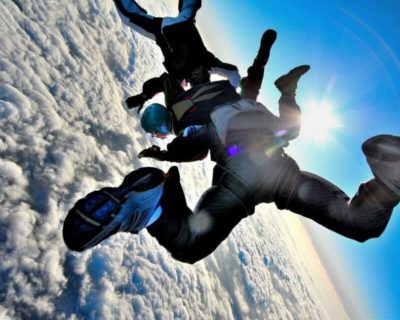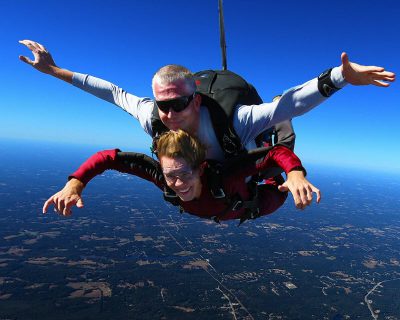So you went skydiving, and you loved it. Your experience occupies your every waking thought and you want it to be your career. We get it! But exactly how do you become a skydiving instructor? Knowing the path for how to become a skydiving instructor can feel like trying to solve a mystery: How long does it take to become a skydiving instructor? How many jumps to be a skydiving instructor? Thankfully, there are very clear steps to gaining the skills, knowledge, and certifications necessary to earn a skydiving instructor rating.
Read on to learn how to become a certified skydiver instructor and answer all the burning questions you have, including “What’s it like to be a skydiving instructor?”
Step 1: Get Your Skydiving License
 Of course, you have to have a skydiving license before you can pursue being a skydiving instructor. It would be awfully hard to facilitate something you’re not even certified to do yourself! To obtain a skydiving license, you have to complete at least 25 skydives and pass a series of written and practical tests.
Of course, you have to have a skydiving license before you can pursue being a skydiving instructor. It would be awfully hard to facilitate something you’re not even certified to do yourself! To obtain a skydiving license, you have to complete at least 25 skydives and pass a series of written and practical tests.
The path to earning your skydiving licensing begins with seven Accelerated Freefall (AFF) jumps with hands-on support from AFF instructors, followed by a series of coach jumps that will teach you the skills needed to fly with other skydivers. After logging 25 jumps, you’re eligible to test for your A License issued by the United States Parachute Association (USPA)!
But that’s not the end of your licensing journey if you’re planning to become a skydiving instructor. There are additional license levels beyond the A license (aptly titled B, C, and D licenses), and each instructor rating requires a different license class. Don’t worry, though, you’re going to need all the experience those licenses give you to be ready to be an instructor!
Step 2: Get to Know the Sport
So you’ve got your license – now what? Even if you’re serious about becoming a skydiving instructor, it’s okay to have a little fun … that’s what skydiving is all about! It’s going to take some time to gain enough experience to attend an instructor-rating course, so enjoy the learning process in the meantime!
It’s a good idea to explore the many options skydiving has to offer before deciding what kind of instructor you want to be. There are various disciplines to learn and even a few different instructor ratings to pursue. And each one has its own set of required skills.
What is a skydiving coach?
The coach rating is the first instructor certification that is available to licensed skydivers and is also a prerequisite for obtaining higher instructor ratings. A skydiving coach works with new jumpers who have just graduated AFF to teach them how to safely fly with others in the sky. Having this rating is a great way to learn about being an instructor and work up to the skills needed to fly with even newer students.
What is an AFF instructor?
An AFF instructor is a highly skilled skydiver with deep knowledge of the sport. They fly with brand-new students on their very first solo jumps and are charged with their students’ curricular instruction, skills development, and safety.
What is a tandem skydive instructor?
Tandem instructors are the workhorses of the skydiving industry and are the first people a new skydiver sees. They have the privilege of experiencing people’s very first skydive attached directly to them, and their expertise sets future skydivers up for success in the student program.
Maybe you only want one rating, or maybe you want to have them all! No matter what, figuring out where your passion lies is an integral part of the process. How many jumps do you need to be a skydiving coach? How about an AFF or Tandem instructor? Well, you’re about to find out!
Step 3: Gain Experience
Each rating has specific prerequisites that must be met before you can even attend the instructor rating course. These requirements increase with the authority of the rating. According to the USPA, each rating requires, at a minimum:
Coach Rating:
- Must be 18+ years old
- Hold a USPA B License or higher
- Have logged at least 100 jumps
- Have assisted in a First Jump Course and pre-course exam
AFF Rating:
- Must be 18+ years old
- Hold a USPA coach rating for a year or have a total of 500 jumps
- Accumulate a total of 6 hours of freefall time
- Hold a USPA coach or other instructor rating
- Hold a USPA C-license or foreign equivalent
- Complete the USPA AFF Instructor rating certification program
Tandem Rating:
- Must be 18+ years old
- Have logged at least 500 jumps
- Have at least 3 years of experience in the sport
- Hold a USPA coach rating
- Hold a USPA D-license or foreign equivalent
- Have an FAA Class III Flight Medical Certificate or foreign equivalent
- Complete the USPA Tandem Instructor rating certification program
Becoming a skydiving instructor is no joke. It takes serious commitment and passion to achieve instructor status. But with a clear vision and the right motivation, you can experience the joy of being on the other side of skydiving student jumps!
Step 4: Complete an Instructor Rating Course
 You have your license, you’ve practiced and practiced … and practiced, and you know what you want to do. You’ve reached your moment: it’s time to get your instructor rating. There are multiple options around the country for skydiving rating courses, so do some research and choose the one that feels like the right fit for you.
You have your license, you’ve practiced and practiced … and practiced, and you know what you want to do. You’ve reached your moment: it’s time to get your instructor rating. There are multiple options around the country for skydiving rating courses, so do some research and choose the one that feels like the right fit for you.
During the course, you’ll sit through extensive ground training to acquire all of the knowledge you need to be an effective instructor. You’ll also get practical, in-sky training to build your skill base and get a glimpse of what skydiving instruction entails. Then, finally, you’ll take written and practical tests that you must pass to earn the title of skydiving instructor.
Once you have your rating, it’s time to use it! The sky’s the limit here (pun intended). Maybe you return to your home dropzone and work as an instructor at the very same place you started skydiving yourself. Or your instructor rating could be your ticket to see the world. Many instructors travel with the seasons and work at different dropzones depending on the time of year.
How much do skydiving instructors make in the US? The answer depends on where you’re working and how often you do instructor jumps. Skydiving instructors are typically paid by the jump and each rating has its pay scale. Continue networking in the sport and meeting new people, and doors will open for you that you never imagined!
Step 5: Keep Learning
One of the best parts about being a skydiving instructor is that the learning never stops. Sure, your job is to teach other people, but that doesn’t mean you’re not continuing to learn just as much yourself. Some of it is on-the-job education that comes naturally from working with other people. Other learning opportunities are more intentional and are even required aspects of the job.
It’s important to stay on top of industry trends and regulations, and staying current on safety protocols is an absolute must. Attending, and maybe even running, an annual Safety Day is the minimum requirement for a skydiving instructor, and you can build on that by going to national industry conferences.
You can also continue to acquire additional ratings to expand your skills and education. Who knows, you might even end up becoming a head instructor or the official Safety & Training Advisor at your dropzone. The possibilities are endless, and being committed to your experience and education is one of the best things you can do to become an incredible skydiving instructor.
Are you ready to start the journey to becoming a professional skydiver? Come take that first leap with us today and see where it leads!
Copyright © 2025, Skydive Monroe, All Rights Reserved.
DropZone Web Design & Marketing by Beyond Marketing, LLC



